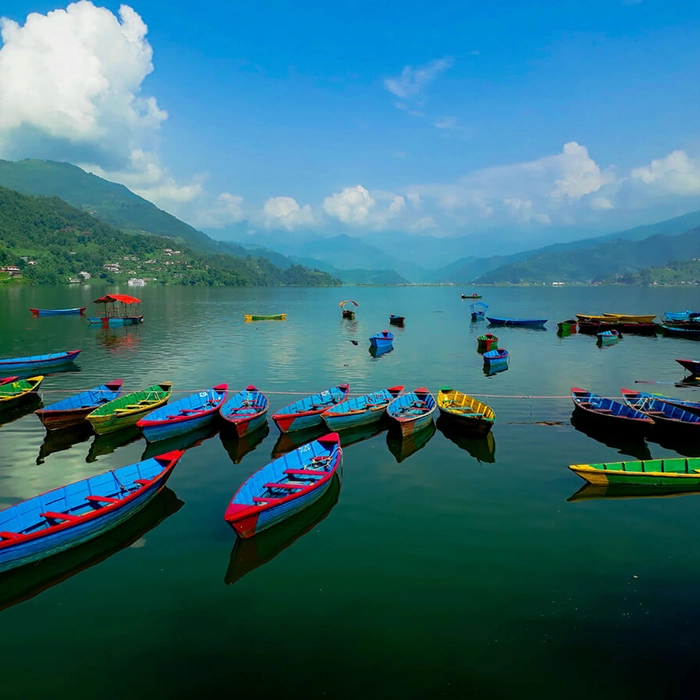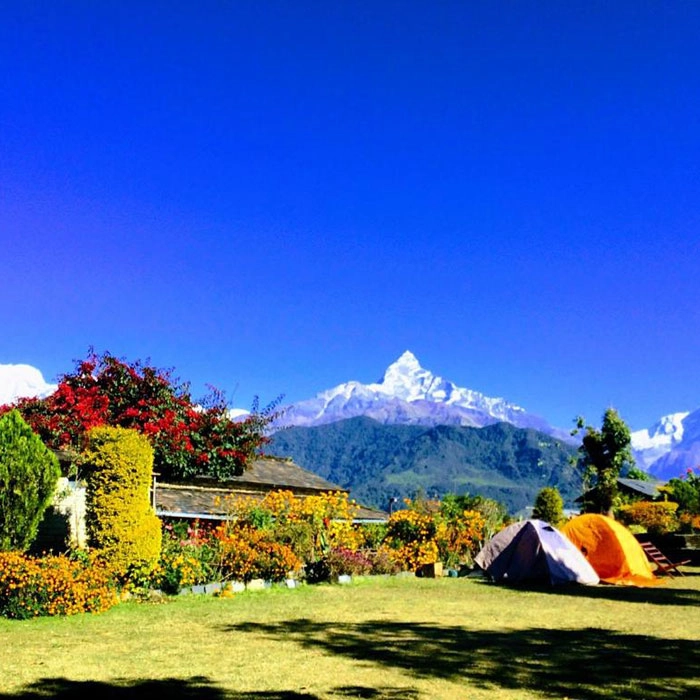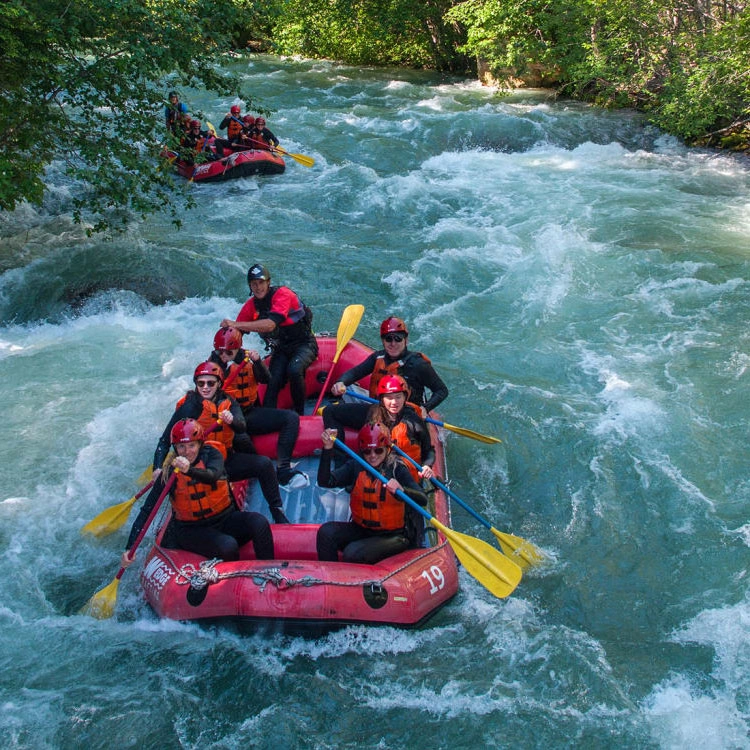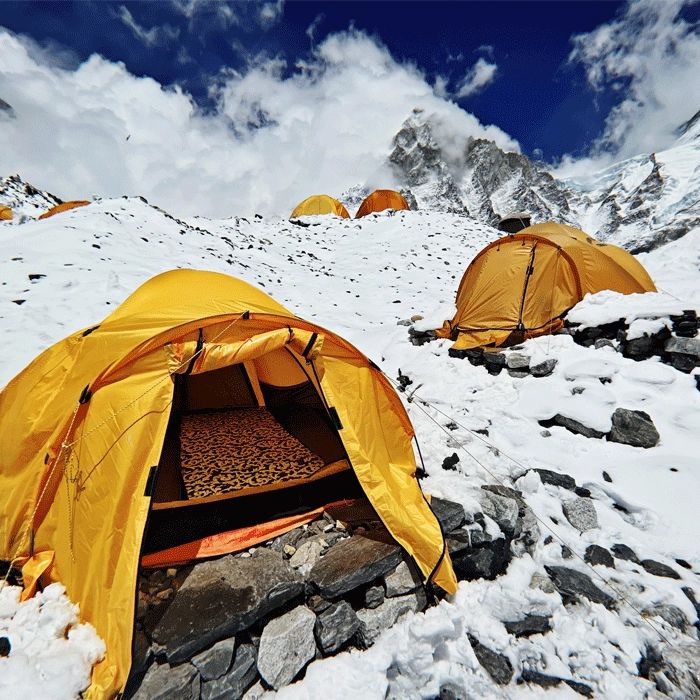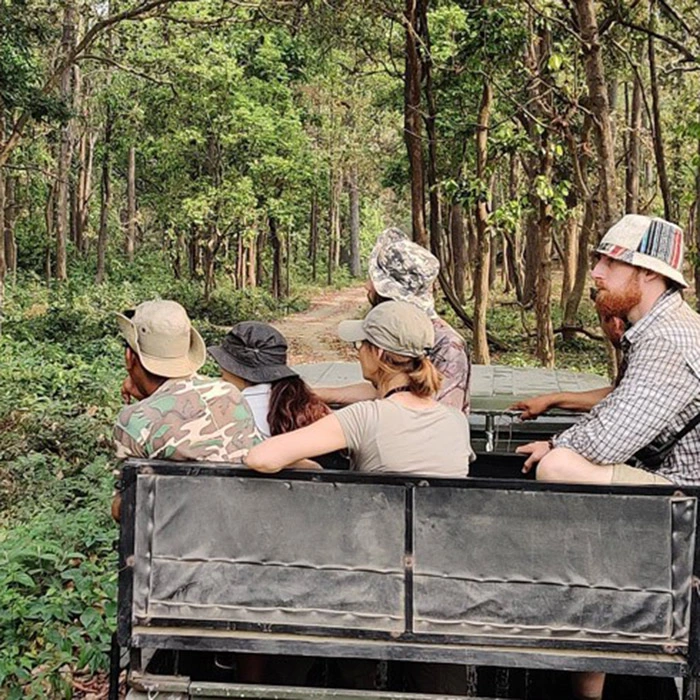JOMSOM MUKTINATH TREK
US$2,250.00
/pp
-
15 Days
-
Annapurna
-
Spring/Autumn
-
Trekking
-
3,760 Meters
-
Moderate
-
Car / Plane
-
01-16 People
-
JH#217
 Overviews
Overviews
Embark on the Jomsom Muktinath Trek with Jagadamba Holidays for a transformative adventure that seamlessly blends spiritual significance with breathtaking natural beauty. This exceptional trek offers a unique journey through Nepal’s high-altitude landscapes and rich cultural heritage, providing an immersive experience in the Himalayas. Your Jomsom Muktinath trek adventure begins in Kathmandu, Nepal’s vibrant capital. Here, explore historic landmarks and UNESCO World Heritage Sites, including ancient Durbar Squares and sacred temples. Immerse yourself in the city’s rich cultural heritage, experiencing the essence of this bustling metropolis. Next, travel to Pokhara, known for its stunning lakes and serene ambiance. Nestled at the base of the Himalayas, this picturesque city offers panoramic views of the Annapurna Range. Enjoy leisure activities by Phewa Lake and prepare for your trek amidst this tranquil setting. From Pokhara, proceed to Lumbini, the birthplace of Lord Buddha. This esteemed location serves as a prominent pilgrimage destination for Buddhists worldwide. Experience the profound spiritual atmosphere, visit ancient monasteries, and gain insights into the Buddhist heritage that defines this historic region. The Jomsom Muktinath trek itself takes you through rugged paths and charming mountain villages, where you’ll encounter traditional caravans of donkeys and ponies transporting goods to remote Mustang. This adds a genuine element to your journey. A key highlight of the Jomsom Muktinath trek is the esteemed Muktinath Temple, a revered destination for both Hindu and Buddhist devotees. Known for its 108 holy ponds, Muktinath Temple represents a convergence of religious traditions, offering a profound spiritual experience. Trekking above the tree line provides spectacular views of the Annapurna and Dhaulagiri ranges, celebrated for their majestic beauty. The Jomsom Muktinath Trek promises awe-inspiring panoramas and a chance to connect with resilient mountain communities. With Jagadamba Holidays’ expert guidance, enjoy a seamless trek that blends spiritual depth with stunning landscapes, creating a memorable and enriching adventure. Best Time to Do Jomsom Muktinath Trek in NepalThe best times to hike Jomsom Muktinath are in the spring (March to May) and the fall (September to November). The weather is clear, the temperatures are mild, and the mountain views are at their best during these times. In the spring, the weather is nice and the rhododendron flowers are bright. In the fall, the air is crisp and the visibility is great after the monsoon. You can also do the trek in the winter (December to February), but it will be colder, especially at night. It's interesting that Jomsom and Muktinath are in the rain shadow of the Annapurna and Dhaulagiri ranges. This means that the trek is possible even during the monsoon season (June to August), when most other trails in Nepal are affected by heavy rain. What Makes Jomsom Muktinath Trek Special?The Jomsom Muktinath Trek is a beautiful mix of different cultures, beautiful scenery, and religious meaning. The trail goes through lush valleys, dry deserts at high altitudes, and traditional villages of Gurung and Thakali people. It is part of the Annapurna Circuit. The best part is getting to Muktinath, a holy pilgrimage site that both Hindus and Buddhists hold in high regard. The eternal flames and 108 water spouts there represent purification. You can also do unique things on the trek, like visit Kagbeni, a medieval village that serves as a gateway to Upper Mustang, and see the big difference between the green mid-hills and the barren Mustang landscapes. Permits Required You need two main permits to go on the Jomsom Muktinath Trek:
You need an Annapurna Conservation Area Permit (ACAP)
TIMS (Trekkers' Information Management System) Card.
Jagadamba Holidays will take care of both permits for you, so you can start your trek without any problems. Safety and Precautions- The hike is mostly safe, but there are some things you should do to stay safe:
- For safety, navigation, and cultural insights, go on a trek with a licensed guide.
- Wear layers so you can deal with the weather changing.
- Drink plenty of water and bring ways to clean it.
- When you visit temples and other religious sites, be sure to follow local customs.
- Be careful of strong winds in Jomsom, which usually get stronger after noon.
- To avoid overdoing it at higher altitudes, walk at a steady pace.
Jomsom Muktinath Trek DifficultyJomsom Muktinath Trek is considered an easy to moderate trek, making it suitable for beginners, families, and trekkers of all ages with basic fitness. The trail ranges between 2,700 to 3,800 meters in elevation, with well-established paths and relatively gentle ascents compared to other Himalayan routes. Trekkers typically walk 4 to 6 hours per day through arid valleys, charming villages, and along the Kali Gandaki River, with fewer altitude-related risks. The presence of roads along parts of the route has made access easier, but still allows for a scenic and culturally rich trekking experience. With good pacing and preparation, the Jomsom Muktinath Trek is a rewarding and accessible journey in Nepal’s Mustang region. Training and Preparation- This trek is not too hard, but getting your body ready will make it more comfortable and fun.
- Hiking, jogging, and biking are all good for your heart and lungs and help you build up your endurance.
- Strengthening your legs and core will help you on days when you have to walk a lot.
- Short hikes with a backpack can help you get ready to carry your own gear.
- It's just as important to be mentally ready for basic accommodations and different types of weather.
Mountain ViewsThe trek gives you amazing views of some of Nepal's most famous peaks and views, like Annapurna, Dhaulagiri, Nilgiri, Tukuche Peak, and Tilicho. The difference between the snow-covered Himalayas and the dry Mustang landscapes is one of the best parts of this trip. Altitude Sickness and PreventionAltitude sickness can happen at about 3,800 meters in Muktinath. Taking acclimatization breaks as needed, trekking slowly, drinking a lot of water, and staying away from alcohol are all ways to avoid getting sick. If you start to feel sick, dizzy, or have a headache, tell your guide right away. If the symptoms get worse, the best thing to do is go down. What to ExpectExpect a hike that combines beautiful views with cultural experiences. You will cross the Kali Gandaki Gorge, which is the deepest gorge in the world, and visit charming villages where the Thakali people are known for their warm hospitality. The trail eventually takes you to the semi-arid Mustang region, where the landscapes look a lot like those in Tibet. At Muktinath, people from all over the world come to cleanse their spirits, making the trip both exciting and spiritually rewarding. Why Choose Jagadamba Holidays for Your Trek?Jagadamba Holidays offers a well-planned Jomsom Muktinath trek that puts safety, comfort, and learning about the culture first. Our knowledgeable guides know the trail inside and out, so you can learn about local customs while hiking smoothly. We take care of all the permits, lodging, meals, and transportation for you, so you can relax. Our carefully planned itineraries let you enjoy the best of the area without stress, whether you're a first-time hiker or an experienced adventurer. Things You Should Know- The strong afternoon winds in Jomsom make it a good idea to go trekking in the morning.
- Jomsom and sometimes Muktinath have ATMs and reliable internet, but not all the time along the trail.
- Lodges have electricity, but you may have to pay a small fee to charge your devices.
- People are expected to dress modestly and act respectfully because the trek goes through religious sites.
Is Jomsom Muktinath Trek for Me?This trek is great for anyone who wants to go on a fairly short and moderate hike that has a lot of cultural and religious meaning. It is good for beginners, families, older trekkers, and people who don't have a lot of time but still want to have a great time in the Himalayas. This trek is for you if you want to see mountains and meet people from other cultures without having to hike too hard. Meals Along the trail, teahouses serve meals that include Nepali staples like dal bhat, Tibetan-inspired dishes like noodle soups and momos, and simple Western foods like pasta, pancakes, and omelets. The food is filling and meant to give you the energy you need for long days of trekking. There are a lot of vegetarian choices. AccommodationThere are places to stay in teahouses and lodges, from basic rooms with shared bathrooms to more comfortable options in bigger towns like Jomsom. The rooms are simple but clean, and they come with blankets. Some lodges offer hot showers for a small fee, and it's a good idea to bring a sleeping bag to stay warm. Plan Your Jomsom Muktinath TrekJagadamba Holidays handles everything for your trek, from getting permits and hiring guides and porters to arranging meals, lodging, and any necessary ground or air transportation. We plan trips that are as safe, comfortable, and fun as possible, and we offer flexible options for individuals, families, and private groups. Highlights- Some of the best parts of the trek are:
- Trekking through the Kali Gandaki Valley, which has the world's deepest gorge
- Going to the holy Muktinath Temple, which is a major pilgrimage site for Hindus and Buddhists
- Visiting Kagbeni village, which is the way to get to Upper Mustang
- Getting to know Thakali culture and their warm welcome
- Views of the Himalayas, including the Annapurna and Dhaulagiri ranges
Why Choose Jomsom Muktinath TrekIf you choose the Jomsom Muktinath Trek, you'll get to enjoy a moderate, easy hike that combines spirituality, culture, and beautiful mountain views. It strikes a good balance between adventure and comfort, so it's good for a lot of different types of trekkers. It is one of Nepal's most rewarding trips because of its religious significance, beautiful scenery, and easy access. Packing List, Gears, and EquipmentTo have a fun and safe hike, bring: - Clothes: Thermal base layers, trekking shirts, fleece and down jackets, waterproof shells, trekking pants, a hat, and gloves
- Shoes: Strong hiking boots (broken in), camp shoes, and warm socks
- Gear: a 40–50L backpack, a 20L daypack, a sleeping bag that can handle temperatures as low as –10°C, and trekking poles
- Essentials: Headlamp, sunglasses, sunscreen, lip balm, and water purification tablets are all things you need.
- Other things: a power bank, a first-aid kit, toiletries, a quick-dry towel, and snacks
Jomsom Muktinath Trek CostThe Jomsom Muktinath Trek cost typically covers all essential services, including a licensed trekking guide, porter support, required permits (ACAP & TIMS), tea-house accommodation, all meals during the trek, and ground transportation to and from the trailhead or flight/driving options to Jomsom. Solo trekkers enjoy personalized attention, while groups can benefit from price reductions as group size increases, thanks to our discounted group rates. We also offer seasonal promotions during off-peak periods to make this spiritual and scenic trek even more affordable. Though our website lists standard international pricing, you're invited to contact us directly for private-group rates, where we guarantee the best value without compromising quality, safety, or service excellence.
 Itinerary (Plan)
Itinerary (Plan)
Arrive in Kathmandu (1,400 m / 4,593 ft.), Nepal's vibrant capital, where you'll be warmly welcomed with marigold garlands. After transferring to your hotel, take time to relax and acclimate to the bustling city. Discover vibrant local markets, indulge in traditional Nepali dishes, and delve into Kathmandu's rich cultural tapestry. This initial day is perfect for easing into your journey, setting the stage for the exciting adventures ahead in Eastern Nepal. A representative from Jagadamba Holidays will ensure a smooth and pleasant arrival.
Optional Evening Activity:
If you wish, you can spend your evening experiencing the Pashupatinath Aarti, a captivating religious ceremony held at the Pashupatinath Temple. The Aarti usually begins around 6:00 PM and lasts for approximately an hour. This ceremony is a mesmerizing display of traditional music and rituals, providing a profound insight into Hindu spiritual practices. Please check the exact time for the Aarti on the day of your visit, as it may vary. This option is not included in the standard itinerary but offers a unique opportunity to immerse yourself in local culture.
Begin your cultural exploration of the Kathmandu Valley at 9 AM with a visit to Patan Durbar Square, renowned for its stunning Newari architecture and historic temples. Continue to Bhaktapur Durbar Square, famous for its medieval charm, exquisite palaces, and the iconic 55-Window Palace. Conclude your day with a visit to Changu Narayan Temple, one of Nepal's oldest Hindu temples, offering rich historical significance and panoramic views of the surrounding valley. This itinerary provides a comprehensive glimpse into Nepal’s architectural heritage and spiritual history.
Patan Durbar Square:
Patan Durbar Square, situated in the heart of Lalitpur, is a remarkable showcase of Newari architecture and culture. This historic square is renowned for its intricate temples, ornate wooden carvings, and beautifully preserved courtyards. Among its most notable structures are the Hiranya Varna Mahavihar, a stunning golden temple, and the Mahabouddha Temple, which resembles the Mahabodhi Temple of Bodh Gaya. The square's centerpiece is the impressive Patan Palace, which houses the Patan Museum, offering a deep dive into Nepalese art, history, and culture.A walk through Patan Durbar Square offers a vivid insight into the Newar culture, where history, spirituality, and artistry converge in a truly captivating environment.
Bhaktapur Durbar Square:
Bhaktapur Durbar Square, a UNESCO World Heritage Site, is an extraordinary example of medieval Newar architecture and urban planning. This historic square is renowned for its majestic temples, palaces, and monuments, each showcasing exquisite craftsmanship. The 55-Window Palace stands out with its intricate wooden windows and rich history, while the Vatsala Temple and Siddhi Lakshmi Temple display elaborate carvings and sculptures. The square also features the iconic Nyatapola Temple, a five-story pagoda dedicated to Siddhi Laxmi, the goddess of prosperity. The dynamic ambiance of Bhaktapur Durbar Square, enhanced by its exquisite artisanal crafts and traditional pottery, affords a profound insight into Nepal's rich cultural and historical heritage.
Changu Narayan Temple:
Changu Narayan Temple, perched atop a hill in the Kathmandu Valley, is one of Nepal’s oldest and most revered Hindu temples. Dedicated to Lord Vishnu, this ancient temple dates back to the 4th century and is celebrated for its rich history and exquisite artwork. The temple complex features intricate carvings, vibrant sculptures, and ancient inscriptions that reflect the artistic prowess of the time. The surrounding area offers panoramic views of the Kathmandu Valley, enhancing the spiritual ambiance of the site. Changu Narayan Temple serves as a living testament to Nepal’s Hindu heritage, with its serene environment and historical significance making it a must-visit destination for those interested in the country’s cultural roots.
Your journey begins with a scenic drive to Pokhara (822 m / 2,697 ft.), a picturesque city nestled beside the serene Phewa Lake. The drive typically takes around 6-7 hours, covering approximately 200 kilometers from Kathmandu. For a more time-efficient and scenic travel experience, consider opting for a short 30-minute flight from Kathmandu to Pokhara instead of the 6-7 hour drive. This premium option, available at an additional cost, offers a breathtaking aerial view of the Himalayan landscape, ensuring a more comfortable and memorable journey.
As you leave the bustling capital, the road winds through lush green hills, terraced farmlands, and charming villages, offering a glimpse of rural Nepalese life. Enjoy the tranquil atmosphere of Pokhara, with the majestic Annapurna range standing tall in the backdrop. This city is the gateway to your trekking adventure, so take time to relax and prepare for the thrilling days ahead.
Start your Jomsom Muktinath Trek journey with a morning flight from Pokhara to Jomsom (2,743 m / 8,999 ft). The scenic flight offers panoramic views of the Annapurna (8,091 m) and Dhaulagiri (8,167 m) ranges, along with the deep Kali Gandaki Gorge. From the air, trekkers can marvel at the contrasting landscapes of snow-capped peaks, terraced farmlands, and winding rivers. Upon arrival in Jomsom, begin your trek to Kagbeni, a historic village where tradition, culture, and the stark beauty of the Mustang region come together. The trek covers about 10.4 kilometers and takes around 3–4 hours, with a gradual elevation gain of 320 meters and a descent of 220 meters. This moderate route allows for smooth acclimatization while offering trekkers the chance to explore the unique arid landscapes of Lower Mustang at a comfortable pace. The trail meanders through narrow valleys, rugged cliffs, and high desert terrain, passing Tibetan-style villages, stone-paved pathways, terraced farmlands, riverbanks, and ancient monasteries. Along the way, trekkers gain an authentic insight into the resilient lifestyle of local Himalayan communities, combining scenic beauty, cultural encounters, and history into a remarkable trekking experience. While much of the trek is in arid landscapes, scattered shrubs and patches of vegetation provide habitat for Himalayan birds and small wildlife. Trekkers can enjoy moments of calm and connection with nature, listening to the subtle sounds of the environment, which adds a peaceful dimension to the journey. At various points, the trail reveals breathtaking panoramas of the Kali Gandaki Valley and the majestic Annapurna and Dhaulagiri peaks, offering trekkers unforgettable Himalayan vistas and perfect opportunities for photography and reflection. These panoramic views create a sense of solitude and wonder, allowing full appreciation of the dramatic Himalayan scenery. The day concludes as you reach Kagbeni (2,804 m / 9,199 ft), where you can check in at a local guesthouse or lodge. Spend the evening wandering through the village, exploring its centuries-old architecture, Tibetan traditions, and cultural significance. Kagbeni marks the gateway to the deeper Jomsom Muktinath Trek, blending nature, culture, and spirituality, and setting the stage for the next phase of your Himalayan adventure.
Start your day with a hearty breakfast in Kagbeni before embarking on the spiritual journey to Muktinath (3,760 m), one of the most revered pilgrimage sites for both Hindus and Buddhists. The trek begins along the Kali Gandaki River, with views of the stark landscapes of the Mustang region and the towering Annapurna and Dhaulagiri ranges in the distance. This route offers a blend of natural beauty, cultural richness, and a sense of anticipation as you move closer to the sacred temple. The trek covers about 11.4 kilometers and takes approximately 4–5 hours, with an ascent of 930 meters and a gentle descent of 10 meters. The trail is moderately challenging, allowing trekkers to gradually adjust to the altitude while experiencing the diverse terrain of the Mustang region. The steady climb ensures a rewarding and manageable day for both experienced hikers and spiritual seekers alike. The route passes through traditional villages such as Jharkot and Khingar, where trekkers encounter old monasteries, chortens, and mani walls inscribed with prayers. These villages provide a glimpse into the unique lifestyle of the Thakali and Tibetan communities, combining cultural immersion with scenic trekking. Along the trail, the stark and arid landscapes slowly give way to lush green hills, forming a visually stunning and diverse trekking route toward the sacred Muktinath Temple, offering trekkers unforgettable Himalayan scenery and cultural immersion. While much of the trek traverses open landscapes, pockets of vegetation and scattered shrubs offer habitat for Himalayan birds and small wildlife. The subtle sounds of nature, from chirping birds to the gentle rustle of leaves, provide a calming atmosphere, enhancing the connection with the surrounding environment and offering peaceful moments along the trail. At several points, the trail opens to sweeping vistas of the Annapurna and Dhaulagiri ranges, with the Kali Gandaki Valley stretching below. These dramatic Himalayan panoramas offer solitude and moments for reflection, photography, and full appreciation of the sacred and rugged landscapes of the Mustang region. The combination of mountains, valleys, and spiritual sites creates an inspiring backdrop for the journey. The day concludes upon reaching Muktinath, where the sacred temple dedicated to Lord Vishnu awaits. Pilgrims and trekkers can explore the 108 stone water spouts (Muktidhara) and the nearby Jwala Mai Temple with its eternal flame, experiencing the spiritual aura of this sacred site. Settle into a cozy teahouse for the night, surrounded by towering peaks and religious monuments. This day’s trek is both physically fulfilling and spiritually enriching, offering a profound connection with the Himalayan culture, nature, and sacred traditions.
Begin your day with a serene morning at Muktinath, a revered pilgrimage site known for its sacred temple complex and spiritual significance. Explore the Muktinath Temple, where 108 water spouts offer a purifying ritual to pilgrims, and the Jwala Mai Temple, where an eternal flame burns alongside a natural water source. This sacred site harmonizes the elements of fire and water, creating a unique spiritual ambiance. The Muktinath Temple is significant for both Hindus and Buddhists, enveloped in an aura of tranquility and divine energy. Spend reflective moments absorbing the serene environment before commencing your trek toward Lupra Village. The trek journey spans nearly 19.7 kilometers and typically takes 6 to 7 hours, making it a rewarding full-day adventure in the high Himalayas. Along the way, trekkers ascend about 570 meters and descend roughly 1,500 meters, navigating paths that alternate between gentle slopes and steep downhill sections. The varied terrain showcases the raw natural beauty and distinct geology of the Mustang region, offering both challenge and breathtaking scenery. The route passes through Lupra Village (2,790 m), one of the few settlements in Mustang preserving the ancient Bon religion. Trekkers encounter traditional Tibetan-style homes, narrow streets, and an old Bon gompa (monastery) adorned with colorful prayer flags. This cultural immersion provides a rare glimpse into centuries-old spiritual traditions of Upper Mustang, enriching the trekking experience while connecting travelers with the unique heritage of Lupra Village and the surrounding Mustang region. While much of the trail traverses open high-altitude terrain, scattered shrubs, alpine grasses, and small groves offer habitat for Himalayan birds and small wildlife. The soothing sounds of nature, from rustling leaves to the calls of native birds, enhance the peaceful trekking experience, providing moments of calm reflection amid the stark landscapes of Upper Mustang. At various points, the trail opens to sweeping vistas of the Kali Gandaki River Valley, the Annapurna Range, and Dhaulagiri Range, along with the desert-like peaks of Mustang. These panoramic Himalayan views provide solitude, exceptional photography opportunities, and a profound sense of awe amid the dramatic and sacred landscapes of Upper Mustang. The day concludes in Jomsom (2,742 m), a vibrant town along the Kali Gandaki River and the main gateway to Mustang. Here, trekkers can relax in cozy guesthouses, explore bustling markets, and enjoy local cuisine. Surrounded by dramatic peaks and expansive river valleys, Jomsom offers the perfect setting to rest, reflect, and celebrate the journey through the high Himalayas. This trek from Muktinath to Jomsom via Lupra is more than a route; it is an enriching blend of natural wonders, cultural depth, and spiritual discovery, leaving every traveler with lasting memories of Upper Mustang’s unmatched charm.
After enjoying a hearty breakfast at your lodge in Jomsom, set out on a scenic trek toward the picturesque Marpha Village (2,670 m). The morning begins with a visit to Thini Village, one of the oldest settlements in Mustang, where traditional Thakali culture is still preserved in stone-built houses and quiet lanes. Just beyond, trekkers reach the sacred Dhumba Lake (2,830 m), where turquoise waters glisten beneath snow-capped Himalayan peaks, creating a serene pilgrimage site in the heart of the Mustang region. Adorned with colorful prayer flags, this holy site for both Hindus and Buddhists provides a tranquil pause to reflect and admire the serene setting. The trekking route from Jomsom to Marpha covers approximately 9 kilometers and takes 4 to 5 hours to complete, with an ascent of 190 meters and a descent of 240 meters. This section of the Annapurna trekking trail is considered relatively easy, offering a comfortable pace for trekkers while showcasing rewarding Himalayan landscapes and rich cultural experiences along the way. Leaving Dhumba Lake (2,830 m) behind, the trekking trail follows the scenic course of the Kali Gandaki River, passing through terraced farmlands and flourishing apple orchards that highlight the cultural and natural beauty of the Mustang region. Small hamlets and traditional farming communities line the trail, where locals tend their fields and livestock, offering an authentic glimpse of rural life in Mustang. This gentle riverside journey balances natural beauty with cultural richness, creating a harmonious trekking experience. Though this section of the trek lies in a semi-arid zone, scattered vegetation, fruit orchards, and riverside greenery bring life to the otherwise rugged terrain. Birdsong and the soothing flow of the river accompany trekkers along the way, providing a refreshing connection to nature amid the high Himalayas. As the trail unfolds, expansive views of the lower Mustang landscapes blend with glimpses of snow-dusted Annapurna and Dhaulagiri ranges. These panoramas offer solitude and moments of quiet reflection, perfect for photography or simply appreciating the grandeur of the Annapurna region. By afternoon, you arrive at the enchanting Marpha Village (2,670 m / 8,760 ft), fondly known as the “apple capital of Nepal.” Famous for its orchards, apple brandy, and cider, Marpha captivates travelers with its whitewashed houses, narrow stone alleys, and traditional monasteries. Cozy teahouses, bakeries, and warm Thakali hospitality make it an ideal place to rest and unwind. This peaceful settlement, framed by dramatic Himalayan peaks, leaves a lasting impression as one of the most memorable highlights of the Annapurna Circuit Trek.
After a hearty breakfast at your lodge in Marpha, you set out on today’s journey toward the remote and scenic village of Kalopani (2,480 m / 8,136 ft). The trail immediately immerses you in the dramatic landscapes of the Kali Gandaki Valley, winding past apple orchards, terraced fields, and the traditional whitewashed houses of the Mustang region. As you trek, the gentle morning light illuminates the surrounding peaks, creating a breathtaking panorama that stretches across the valley. Your path first leads you to Chhairo (2,738 m / 8,983 ft), a village famed for its historic Chhairo Monastery, one of the oldest in Mustang. Here, you can explore the monastery’s ancient walls, prayer wheels, and colorful murals, soaking in the spiritual atmosphere that has drawn pilgrims for centuries. The combination of cultural heritage and natural beauty makes this segment of the trek both inspiring and memorable. From Chhairo, the trail continues to Kothethanti (2,657 m / 8,714 ft), passing through quiet hamlets and open landscapes dotted with stone walls, grazing livestock, and riverside paths along the Kali Gandaki River. The trek from Marpha to Kalopani involves a steady ascent of 410 meters and a descent of 570 meters, covering roughly 21 kilometers in 6–7 hours. Along the way, the rugged valley opens up to spectacular views of the surrounding Himalayan peaks, including the looming silhouettes of Dhaulagiri and Annapurna, creating endless opportunities for photography and reflection. Walking through these remote villages, you witness the daily life of local communities, from farmers tending their terraced fields to children playing along the trail, giving a deeply immersive experience of Mustang’s unique culture. The trail continues alongside the Kali Gandaki River, unveiling dramatic landscapes and endless mountain vistas. By the afternoon, you reach Kalopani, a tranquil village renowned for its breathtaking views of the Dhaulagiri and Annapurna ranges. The serene environment of Kalopani makes it an ideal place to rest, offering various accommodation options and a peaceful setting to recover before continuing your journey along the Annapurna Circuit Trek.
After a hearty breakfast at your lodge in Kalopani, you set out on today’s journey toward the serene village of Tatopani (1,190 m / 3,904 ft), passing through Kopchepani along the way. The trail immediately immerses you in the lush landscapes of the lower Kali Gandaki Valley, winding through dense forests, terraced fields, and riverside paths that offer ever-changing vistas of the surrounding Himalayan foothills. As you descend along the Kali Gandaki Valley Trek, the morning sunlight filters softly through the forest canopy, highlighting the lush greenery and offering occasional glimpses of the sparkling Kali Gandaki River, one of the most picturesque rivers in the lower Mustang region. Your path first leads you to Kopchepani (1,926 m / 6,318 ft), a small village nestled amid terraced fields and forested slopes. Here, you can pause to enjoy the peaceful surroundings, observe local farmers tending their crops, and take in the natural beauty that defines this remote region. The combination of scenic landscapes and authentic village life makes this segment of the trek both calming and memorable. From Kopchepani, the trail continues its gradual descent toward Tatopani, weaving through forests of rhododendron, pine, and oak, interspersed with traditional villages and farmland. The trek from Kalopani to Tatopani involves a steady ascent of 190 meters and a descent of 1,470 meters, covering roughly 24 kilometers in 6–7 hours. Along the way, you are treated to breathtaking views of towering peaks, deep river valleys, and the vibrant flora of the lower Mustang region, offering endless opportunities for photography and quiet reflection. By early afternoon, you reach Tatopani, a charming village famous for its natural hot springs, offering trekkers a perfect spot to relax and rejuvenate after the day’s journey along the Kali Gandaki Valley Trek. The warm waters provide the perfect way to soothe tired muscles after several days of trekking. Tatopani’s peaceful atmosphere, combined with its range of accommodation options and local amenities, makes it an ideal stopover before continuing your journey along the Annapurna Circuit Trek. Whether you choose to soak in the mineral-rich springs, stroll through the village, or simply enjoy the tranquil mountain views, Tatopani offers a restful and memorable experience for every trekker.
After a hearty breakfast at your lodge in Tatopani, you set out on today’s journey toward the picturesque village of Ghorepani (2,860 m / 9,383 ft), passing through the villages of Shikha (1,799 m / 5,899 ft) and Chittre (2,311 m / 7,582 ft) along the way. The trail immediately begins its ascent, winding through lush forests of rhododendron, oak, and pine, and offering glimpses of terraced fields that showcase the agricultural practices of the lower Annapurna region. As you trek, the path gradually climbs, revealing panoramic views of the surrounding Himalayan peaks, including the majestic Annapurna and Dhaulagiri ranges. The morning light illuminates the verdant landscape, creating an inspiring backdrop for photography and quiet reflection. Your route first passes through Shikha, a small village known for its friendly locals and traditional stone houses, followed by Chittre, where the combination of forested slopes and cultivated terraces captures the essence of rural Nepal. The trek from Tatopani to Ghorepani involves a steady ascent of 1,670 meters and a minor descent of 40 meters, covering roughly 15 kilometers in 7–8 hours. By early evening, you arrive at Ghorepani, a charming village celebrated for its breathtaking panoramic views of the Annapurna and Dhaulagiri ranges. Ghorepani is a popular stop on the Annapurna Circuit Trek, known for its vibrant local atmosphere and warm hospitality. The village provides an ideal resting point before the early morning hike to Poon Hill, allowing trekkers to relax, enjoy the serene surroundings, and prepare for the spectacular sunrise that awaits at one of Nepal’s most iconic viewpoints. For those seeking an extra adventure, Poon Hill (3,210 m / 10,531 ft) can also be visited for a sunset experience. While it is traditionally famous for its sunrise views, trekking up in the late afternoon offers a serene opportunity to witness the sun casting golden hues across the Annapurna and Dhaulagiri ranges, painting the Himalayan peaks in breathtaking colors. The peaceful evening light and panoramic vistas make this a memorable alternative for trekkers wishing to capture sunset photography or enjoy a quieter moment above Ghorepani.
Wake up early to hike to the iconic Poon Hill (3,210 m / 10,531 ft), one of the most celebrated viewpoints in the Annapurna region, Nepal, offering breathtaking sunrise vistas and panoramic views of the Himalayas. The hike is approximately 2.75 km (1.7 mi) round trip, taking 1.5–2 hours with a 270 m ascent and descent. From the summit of Poon Hill, witness a spectacular sunrise as golden light bathes the snow-capped peaks of Annapurna, Dhaulagiri, Machhapuchhre (Fishtail), and Nilgiri, creating unforgettable Himalayan panoramas. This unforgettable sunrise experience at Poon Hill is globally recognized as a must-visit destination, providing trekking enthusiasts with unparalleled photography opportunities and a profound connection with the majestic Himalayas of Nepal.
The Ghorepani to Hile Village trek (1,430 m) covers approximately 11 kilometers and takes 5–6 hours, providing trekkers with a comfortable yet rewarding journey along the renowned Annapurna trekking trail. The trek features a descent of 1,430 meters with no significant ascents, allowing trekkers to enjoy scenic downhill trekking through lush forests, traditional villages, and panoramic Himalayan landscapes. After witnessing the spectacular sunrise at Poon Hill, trekkers return to Ghorepani for a hearty breakfast before descending toward Hile Village. The trail winds through vibrant rhododendron forests and charming traditional Himalayan villages, showcasing the region’s rich culture. Trekkers will encounter cascading waterfalls along the route, adding to the natural beauty of the journey. The trek also provides sweeping panoramic views of the Annapurna and Dhaulagiri ranges, offering an unforgettable scenic trekking experience in Nepal. The trail descends through traditional villages such as Ulleri and Tikhedhunga, passing terraced farmlands and stone-built homes that reflect the centuries-old lifestyles of the Gurung and Magar communities. These villages provide cultural immersion, allowing trekkers to experience the authentic mountain life of rural Nepal, complementing the natural beauty along the trail. Trekking through lush rhododendron and oak forests, you will encounter seasonal blooms, flowing streams, and cascading waterfalls. This serene forested section is home to native Himalayan birds and small wildlife, offering trekkers moments of calm and reflection amid the peaceful natural environment. As the trail opens, expansive views of the Annapurna and Dhaulagiri ranges emerge alongside cascading hills and deep valleys. These panoramic vistas offer solitude, excellent photography opportunities, and a profound appreciation of the dramatic Himalayan scenery, enhancing the overall trekking experience in the Annapurna region. The day concludes upon reaching Hile Village (1,430 m), where trekkers can embark on a scenic jeep transfer to Pokhara (822 m). The 50 km drive, lasting 2–3 hours, reveals stunning views of rivers, rolling hills, and verdant valleys. Upon arrival in Pokhara, check into your hotel and spend the remainder of the day exploring highlights such as Phewa Lake, the World Peace Pagoda, or the vibrant lakeside market. This day seamlessly blends the iconic Poon Hill sunrise, cultural immersion in traditional villages, and the serene beauty of Pokhara, culminating in a memorable conclusion to the Annapurna trekking experience.
Begin your journey with a scenic drive from Pokhara to Lumbini (150 m), the sacred birthplace of Buddha, traversing the historic hill towns of Tansen and Palpa (1,350 m). This drive offers a blend of cultural exploration and natural beauty, taking you through rolling hills, terraced farmlands, and picturesque rivers, setting the stage for a spiritual and enriching experience. The route spans approximately 200 kilometers and takes about 6 to 7 hours, making it a full-day journey. The drive is moderately comfortable, with gentle ascents and descents as you pass through hilly terrain, offering ample opportunities to enjoy Nepal’s scenic landscapes while experiencing its cultural richness along the way. As you depart Pokhara, the road winds through lush countryside, providing glimpses of the distant Annapurna and Dhaulagiri ranges. The journey first leads to Tansen, a charming hill town famed for its traditional Newari architecture, historic palaces, and panoramic hilltop views. Explore its ancient temples, bustling local markets, and intricate woodwork before continuing toward Palpa, a town renowned for the Rani Mahal palace overlooking the Kali Gandaki River and its serene, historical ambiance. Along the route, dense Himalayan forests and scattered woodlands provide thriving habitats for native birds and wildlife, enriching the scenic drive with Nepal’s authentic natural beauty. Seasonal blooms, roadside vegetation, and riverine greenery enhance the scenic drive, offering a subtle connection with nature amid the hilly terrain. As the drive continues south, the vistas open to expansive plains and distant hill slopes, offering travelers moments of calm and solitude. Panoramic views of terraced fields, rivers, and the gradual transition from hills to flatlands provide excellent photo opportunities and a sense of Nepal’s diverse landscapes. The journey concludes upon reaching Lumbini, a UNESCO World Heritage Site and one of the most important pilgrimage destinations in the world. Explore the revered Maya Devi Temple, the surrounding monastic zones representing diverse Buddhist traditions, and the tranquil sacred garden, immersing yourself in Lumbini’s spiritual and cultural heritage. Check into your accommodation and spend time reflecting on the spiritual and cultural significance of this revered birthplace, completing a journey that seamlessly blends scenic landscapes with profound heritage.
Embark on a profound journey to Lumbini, the revered birthplace of Siddhartha Gautama, who attained enlightenment to become Buddha. This UNESCO World Heritage Site, located in the Rupandehi District of Nepal, is a focal point for Buddhist pilgrimage and offers a deeply enriching experience. The tour begins with a visit to the Sacred Garden, the heart of Lumbini, where the Maya Devi Temple stands. This ancient temple marks the exact spot where Queen Maya Devi gave birth to Prince Siddhartha in 563 BCE. The temple’s architecture is both spiritual and historical, featuring ancient ruins and a sacred pond where the queen is believed to have bathed. The temple complex includes a newly constructed shrine, which is a modern addition to the historic site, providing a serene space for meditation and reflection. Next, explore the Lumbini Museum, which houses an extensive collection of artifacts related to Buddha's life and the archaeological findings from the site. The museum offers a comprehensive overview of the history and significance of Lumbini, enriching your understanding of its cultural and spiritual heritage. As you continue the tour, visit various international monasteries within the Lumbini Monastic Zone. Each monastery represents different Buddhist traditions and architectural styles, reflecting the global significance of Lumbini. These monasteries provide a unique glimpse into the diverse interpretations of Buddhism and offer tranquil spaces for contemplation. The tour also includes a visit to the Ashoka Pillar, an important historical monument erected by Emperor Ashoka in 249 BCE to commemorate his pilgrimage to Lumbini. The pillar’s inscriptions detail the significance of Lumbini as a Buddhist site. Conclude your visit with a peaceful walk through the lush surroundings of the Sacred Garden and the surrounding meditation parks, where you can reflect on the profound historical and spiritual experiences of the day. Lumbini, with its rich heritage and serene atmosphere, offers an unforgettable journey into the heart of Buddhism and the life of Buddha.
After a hearty breakfast at your hotel in Lumbini, proceed to Bhairahawa Airport to conclude your Lumbini spiritual and heritage tour with a scenic return flight to Kathmandu. Upon arrival in Kathmandu, a thoughtfully arranged guided tour offers an immersive experience of the city’s spiritual and cultural landmarks. Explore the sacred Pashupatinath Temple, a revered Hindu pilgrimage site; the monumental Boudhanath Stupa, one of the largest Buddhist stupas in the world; and the iconic Swayambhunath Stupa (Monkey Temple), which provides panoramic views of Kathmandu Valley. This day combines breathtaking aerial vistas from the flight with a rich exploration of Kathmandu’s UNESCO World Heritage sites, blending cultural discovery with profound spiritual insights for a memorable conclusion to your Nepal spiritual and heritage journey. Pashupatinath Temple:
Pashupatinath Temple is one of the holiest Hindu shrines in Nepal, situated on the banks of the Bagmati River in Kathmandu. This revered temple complex, dedicated to Lord Shiva, is a UNESCO World Heritage Site and attracts thousands of pilgrims annually. The pagoda-style architecture features intricate wooden and metal carvings. It serves as a significant center for Hindu rituals and cremation ceremonies, with sacred sadhus and lively ghats enhancing the spiritual ambiance. Visitors can experience traditional Hindu worship practices and the cultural richness of this sacred site. Boudhanath Stupa:
Boudhanath Stupa is a colossal and spiritually significant Buddhist monument in the heart of Kathmandu. As one of the largest stupas in Nepal, it is a major pilgrimage site for Tibetan Buddhists. The whitewashed dome and golden spire symbolize the universe, surrounded by prayer flags and Mani stones. Pilgrims circumambulate the stupa while spinning prayer wheels and chanting mantras, creating a serene meditative atmosphere. The area is known for its vibrant Tibetan culture, with monasteries, shops, and eateries offering insights into Tibetan life and spirituality. Swayambhunath Stupa (Monkey Temple):
Swayambhunath Stupa, also known as the Monkey Temple, is an ancient religious site perched on a hilltop overlooking Kathmandu Valley. This important Buddhist pilgrimage site offers panoramic views of the city and surrounding landscapes. The golden spire adorned with Buddha’s eyes symbolizes his omnipresence. The temple complex includes various shrines, temples, and monasteries, while a population of playful monkeys adds to its unique charm. Visitors can experience a rich tapestry of religious and cultural heritage in this iconic Kathmandu landmark.
Concluding Your Journey in Nepal
As your remarkable journey through the Himalayas comes to an end, take a moment to reflect on the awe-inspiring natural beauty, rich cultural heritage, and memorable experiences that have defined your time in Nepal. From the majestic mountain landscapes to the warm hospitality of the local communities, every moment has contributed to an unforgettable adventure.
Airport Transfer by Jagadamba Holidays
To ensure a smooth and timely departure, an official representative from Jagadamba Holidays will collect you from your hotel 3.5 hours prior to your scheduled flight departure. Our team is committed to providing a reliable and comfortable transfer service to Tribhuvan International Airport, allowing you to conclude your journey with peace of mind.
We sincerely appreciate your trust in Jagadamba Holidays and hope to have the pleasure of serving you again on your future journeys.
Quotation 2025
| Group Size (Pax) |
1 - 2 |
3 - 4 |
5 - 6 |
7 - 8 |
9 - 12 |
13 - 16 |
17 - 20 |
21 - 24 |
25 - 32 |
| Cost Per Person |
$2,025 |
$1,995 |
$1,965 |
$1,935 |
$1,905 |
$1,875 |
$1,845 |
$1,805 |
$1,755 |
 Cost Include
Cost Include
- All transfers within Nepal are included as per itinerary
- Any domestic flight of Nepal as per trekking itinerary
- Trekking accommodation (hotel, lodge and/or tent) as per itinerary
- Small shared room with shared bathroom during trek in Nepal
- In Kathmandu and/or Pokhara: Stay at ***Hotel with breakfast
- Luggage for porters during the trek (12.5 kg/person)
- 3 meals (Breakfast, Lunch and Dinner) during the trek
- Unlimited tea or coffee for breakfast during the trek
- An English speaking guide (trekking/tour) as per Itinerary
- Travel insurance for trekking staff (guides and porters)
- All expenses of trekking staff(s) during trekking
- Includes all conservation, national park, trekking, and climbing permits
- Sightseeing / Wildlife tours if included in the itinerary
- Farewell dinner in Kathmandu before returning home
 Cost Exclude
Cost Exclude
- Single room/single tent surcharge (on request)
- Round trip/one way international flight ticket to Nepal.
- Tourist visa for Nepal (30-50 $, depending on length of stay)
- Personal Insurance (covers: Trip/flight cancellation, helicopter rescue)
- Meals (lunch, dinner) at hotels in Kathmandu, Pokhara and other cities
- Drinks (soft, hot or mineral/boiled water) during the lodge trek
- Any personal trekking and/climbing equipment for trekking in Nepal
- Hotel expenses in case of early return from trekking for any reason
- Costs due to flight cancellations & extra porters/horses during the trek
- Additional costs incurred due to any reason beyond Jagdamba’s control
- More evidence about pandemics like COVID-19 if needed in the future.
- Personal expenses during the trek (phone, wifi, shower, charging etc.)
- Other costs and things that are not mentioned in the service inclusion
- Gratuity for trekking staff (recommended: 9€ /10$ per traveler per day)
|







 Overviews
Overviews
 Trip Overview
Trip Overview
 Travel Itinerary
Travel Itinerary
 Cost Include
Cost Include
 Cost Exclude
Cost Exclude
 Fixed Departure
Fixed Departure
 Route Map
Route Map

 Freqeuntly Asked Questions
Freqeuntly Asked Questions
 Reviews And Rating
Reviews And Rating
